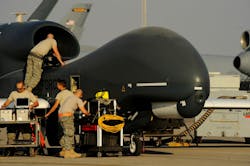Researchers developing communications networking for unmanned surveillance vehicles for GPS-denied missions
WASHINGTON – Imagine several dispersed, yet interconnected medium-altitude surveillance drones discover a massive, fast-approaching enemy armored force on the other side of a mountain range, advancing quickly to attack. Kris Osborn at The National Interest reports. Continue reading original article
The Military & Aerospace Electronics take:
15 Dec. 2021 -- What if before the drones could send real-time video to command and control centers, communications were jammed, destroyed or disrupted? How could the drones continue the mission?
The possibility of encountering this kind of scenario drives a fast-emerging technology program called Distributed Autonomy Responsive Control (DARC), which enables unmanned systems to form mesh networks to perform functions independently of human decision-makers.
Described as software by Northrop Grumman developers, DARC pre-programs drones with mission and navigational details to work in denied, jammed, or otherwise inoperable environments.
John Keller, chief editor
Military & Aerospace Electronics
